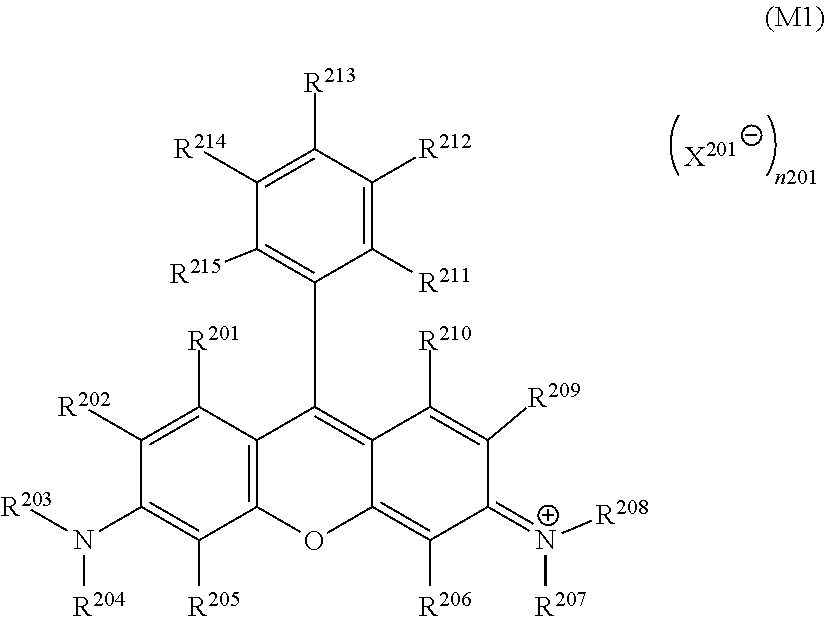Inkjet textile printing method, coloring composition, inkjet ink, ink cartridge, and dye polymer
a dye polymer and textile printing technology, applied in dyeing process, other chemical processes, inks, etc., can solve the problems of poor quality of colored cloths, waste of materials, poor environmental load of waste liquid,
- Summary
- Abstract
- Description
- Claims
- Application Information
AI Technical Summary
Benefits of technology
Problems solved by technology
Method used
Image
Examples
synthesis example 1
Synthesis of Dye Polymer (D-1-5)
[0223]Exemplary compound (D-1-5) was synthesized by the following scheme.
[0224]
[0225]To a 200-mL three-neck flask, 5.0 g of D-1, 1.05 g of 2,2-bis(hydroxymethyl)propionic acid, and 61.2 g of N-methylpyrrolidone (NMP) were added, and heated to an internal temperature of 90° C. To this, 164 mg of NEOSTANN U-600 (manufactured by Nitto Kasei Co., Ltd., trade name), and 4.96 g of 1,6-hexamethylene diisocyanate were added. After completion of the dropping, the reaction was caused at 90° C. for 4 hours. The reaction solution was left to cool to 20° C., and poured into 600 mL of a 0.1 mol / L sodium hydroxide aqueous solution; subsequently, 660 mL of 1 mol / L aqueous hydrochloric acid was added, and filtration was performed. The resultant residue was added to 600 mL of a 0.1 mol / L sodium hydroxide aqueous solution, and stirred for 10 minutes; subsequently 1 mol / L aqueous hydrochloric acid was added to adjust the pH to 5.2; and filtration was performed. The resul...
example 1
Production of Dye Polymer Aqueous Dispersion (1)
[0237]Exemplary compound (D-2-1) (1.0 g), 10 g of zirconia beads (manufactured by Nikkato Corporation, trade name: YTZ ball, diameter: 0.1 μm), 0.2 g of sodium oleate, and 3.8 g of ultrapure water were added, and a planetary micro mill (manufactured by FRITSCH, Pulverlsette 7) was used to perform dispersion at 400 rpm (revolution per minute) for 10 hours. From the resultant dispersion liquid, zirconia beads were removed with a filter cloth, to obtain Dye polymer aqueous dispersion (1). The weight-average molecular weight of the dye polymer used, and the average particle size of the particulate dye polymer of the resultant dye polymer aqueous dispersion are described in Tables 1 and 2.
examples 2 to 23
[0238]Similarly, Dye polymer aqueous dispersions (2) to (23) were produced except that the dye polymer and the low-molecular surfactant or high-molecular dispersing agent were changed to the types and amounts described in the following Tables 1 and 2. DEMOL NL is manufactured by Kao Corporation.
[0239]
TABLE 1Low-molecular surfactant WeightAverageDyeor high-molecular average particlepolymerDye polymerdispersing agent usedmolecularsizeaqueousAmountAmountweightMvExampledispersionType(g)Type(g)(Mw)(nm)Example 1(1)(D-2-1)1.0Sodium oleate0.210,500110Example 2(2)(D-2-2)1.0Sodium oleate0.29,90082Example 3(3)(D-2-3)1.0Sodium oleate0.211,60064Example 4(4)(D-2-4)1.0Sodium oleate0.213,20039Example 5(5)(D-2-5)1.0Sodium oleate0.212,70032Example 6(6)(D-2-6)1.0Sodium oleate0.211,90091Example 7(7)(D-2-7)1.0Sodium oleate0.212,20098Example 8(8)(D-2-8)1.0Sodium oleate0.29,60062Example 9(9)(D-2-9)1.0Sodium oleate0.211,40052Example 10(10)(D-2-10)1.0Sodium oleate0.22,400275Example 11(11)(D-2-11)1.0Sodium o...
PUM
| Property | Measurement | Unit |
|---|---|---|
| particle size | aaaaa | aaaaa |
| mass % | aaaaa | aaaaa |
| mass % | aaaaa | aaaaa |
Abstract
Description
Claims
Application Information
 Login to View More
Login to View More - R&D
- Intellectual Property
- Life Sciences
- Materials
- Tech Scout
- Unparalleled Data Quality
- Higher Quality Content
- 60% Fewer Hallucinations
Browse by: Latest US Patents, China's latest patents, Technical Efficacy Thesaurus, Application Domain, Technology Topic, Popular Technical Reports.
© 2025 PatSnap. All rights reserved.Legal|Privacy policy|Modern Slavery Act Transparency Statement|Sitemap|About US| Contact US: help@patsnap.com



